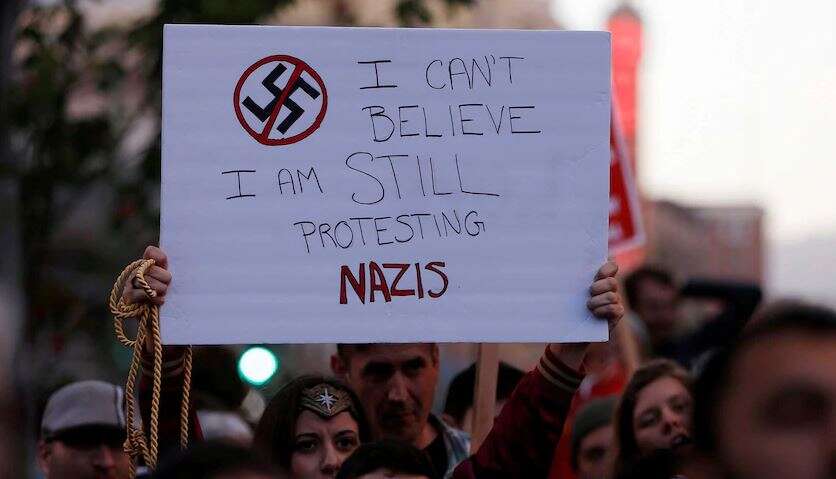The Combat Antisemitism Movement revealed in its latest monthly report that it monitored 19 physical attacks targeting Jews in January, which represents a 90% increase from the same time period last year.
Follow Israel Hayom on Facebook, Twitter, and Instagram
In total, CAM tracked 158 antisemitic incidents reported in the media in January, marking a 9.2% decrease from January 2021's 174 incidents.
In January of this year, 58.2% (92 incidents) were associated with far-right motives, 13.9% (22 incidents) had far-left motives, and 13.3% (21 incidents) had motives tied to Islam. The remaining 14.6% (23 incidents) had "unidentifiable motives."
CAM noted that the month saw a 14.1% increase in far-right antisemitic incidents compared to 2021, while there was a decrease of 5.2%, 5.8% and 3.1% in the far-left, Islamist and unidentifiable cases, respectively. There were 45 antisemitic vandalisms recorded in January, an 8.2% decrease from the previous year.
On the positive side, it highlighted nine "adoptions and endorsements" of the International Holocaust Remembrance Alliance (IHRA)'s working definition of antisemitism took place in January, in Alabama, Nevada, Oklahoma, Tennessee, Utah, Virginia, and West Virginia, the town of Southampton in New York and Argentina's Santa Fe Province.
The watchdog group also monitored antisemitic incidents in the three months leading up to the Jan. 15 hostage terrorist attack at Congregation Beth Israel in Colleyville, Texas. In the three-month period ahead of the attack, the Jewish group tracked 34 incidents around the world that targeted synagogues and Jewish centers, and 65% of which took place in the United States.
There was also a "spike in coordinated social-media activity" calling for the release of "Lady Al-Qaida" convicted terrorist Aafia Siddiqui leading up to the hostage-taking situation, CAM said last week.

Meanwhile, the newer strains of far-right movements fueled by conspiracy theories, misogyny and anti-vaccine proponents contributed to a modest rise in killings by domestic extremists in the United States last year, according to a report released Tuesday by the Anti-Defamation League.
Killings by domestic extremists increased from 23 in 2020 to at least 29 last year, with right-wing extremists killing 26 of those people in 2021, the Anti-Defamation League said in a report first provided to The Associated Press.
The ADL's report says white supremacists, antigovernment sovereign citizens and other adherents of long-standing movements were responsible for most of the 19 deadly attacks it counted in 2021. The New York City-based organization's list also included killings linked to newer right-wing movements that spread online during the coronavirus pandemic and former President Donald Trump's presidency.
The ADL concluded that roughly half of the 2021 killings didn't have a clear ideological motive, fitting a pattern that stretches back at least a decade.
The group's tally included a shooting rampage in Denver by Lyndon James McLeod, who killed five people in December before a police officer fatally shot him. McLeod was involved in the "manosphere," a toxic masculinity subculture, and harbored revenge fantasies against most of his victims, the ADL report notes.
Right-wing conspiracy theorists killed five people last year in two incidents, both involving "troubled perpetrators," the ADL report says.
In August, California surfing school owner Matthew Taylor Coleman was charged with killing his two young children with a spear gun in Mexico. Coleman told an FBI agent that he was "enlightened" by conspiracy theories, including QAnon, and believed his wife had passed "serpent DNA" on to his children, according to a court affidavit.
A Maryland man, Jeffrey Allen Burnham, was charged with killing his brother, his sister-in-law and a family friend in September. Charging documents said Burnham confronted his brother, a pharmacist because he believed he was poisoning people with COVID-19 vaccines.
"Prior to the coronavirus, the anti-vaccine movement in the United States did not have a particular ideological leaning and contained both left-leaning and right-leaning activists," the ADL report says. "However, the politicization of the coronavirus and other factors have created many new anti-vaccine conspiracy adherents and given the anti-vaccine movement a distinctly right-wing tone it did not previously have."
The QAnon conspiracy theory has been linked to other acts of real-world violence, including last year's riot at the US Capitol. In June, a federal intelligence report warned that QAnon adherents could target Democrats and other political opponents for more violence.
A core idea QAnon promotes is that Trump was secretly fighting a Satan-worshipping, child sex trafficking cabal of "deep state" enemies, prominent Democrats and Hollywood elites. QAnon hasn't faded away with Trump leaving office.
Mark Pitcavage, a senior research fellow at the ADL's Center on Extremism and author of Tuesday's report, said the QAnon movement is still evolving and increasingly overlapping with other extremist movements, including vaccine opponents.

"The policy of removing [offensive] content is inconsistent and it varies between the social media platforms and their response time is grossly lacking," FOA YouTube
A dearth of mass killings in 2021 meant that last year's tally was far lower than the totals in any year between 2015 and 2019, when killings by domestic extremists ranged from 45 to 78.
In other respects, the ADL data for 2021 mirrors long-term trends.
Right-wing extremists have killed at least 333 people in the US over the past decade, accounting for three-quarters of all extremist-related killings, the report says.
The ADL distinguishes between killings that it considers to be driven by ideology and those that it found to be non-ideological or lacking a clear motive. Its report says the numbers for each category have been close to even over the past 10 years. The ADL concluded that 14 of the 29 extremist killings in 2021 were apparently motivated at least in part by ideology.
The ADL attributed 13 killings last year to white supremacists, three to anti-government extremists, two to Black nationalists and one to an Islamist extremist.
The group didn't count the death of Capitol Police officer Brian Sicknick during the Capitol riot on Jan. 6, 2021, as an extremist killing. Sicknick collapsed and died hours after he was attacked by rioters who stormed the Capitol and interfered with Congress' certification of President Joe Biden's electoral victory. In April, the Washington, DC, medical examiner's office ruled that Sicknick suffered a stroke and died from natural causes.
"Although it is clear that the Capitol attack could have contributed to, or even precipitated, the strokes that felled Sicknick, it cannot be definitely proven that he was murdered by a Capitol stormer," the ADL report says.
Subscribe to Israel Hayom's daily newsletter and never miss our top stories!




